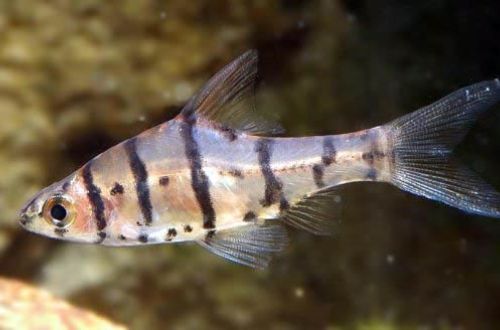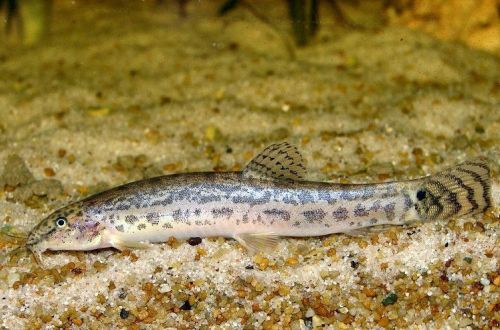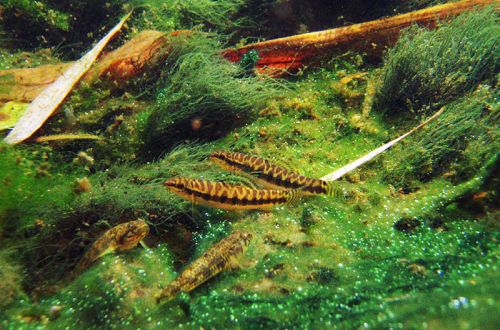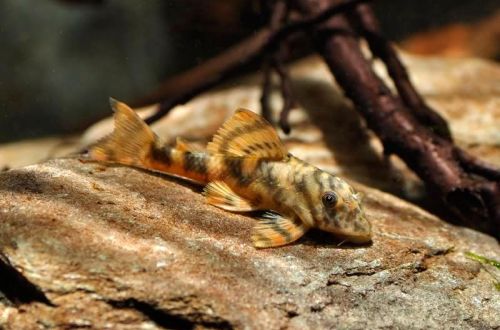
Eight-striped barbus
Eight-streaked barb or Eight-striped barb, scientific name Eirmotus octozona, belongs to the Cyprinidae family. Small schooling peaceful fish, will be a good addition to the community of freshwater small fish. Relatively easy to maintain.

Contents
Habitat
It comes from Southeast Asia from the Malay Peninsula and the island of Kalimantan. They inhabit reservoirs of river backwaters, lakes, as well as peat bogs located among tropical rainforests. A typical biotope is a reservoir with dense aquatic vegetation, silty substrates, covered with a layer of fallen leaves, branches, muddy brown water.
To date, wild populations have survived only on the island of Kalimantan. The natural habitat has been destroyed by human activities.
Brief information:
- The volume of the aquarium – from 40 liters.
- Temperature – 22-26°C
- Value pH — 5.0–7.0
- Water hardness – 1–8 dGH
- Substrate type – any dark
- Lighting – subdued
- Brackish water – no
- Water movement – little or no
- The size of the fish is 3–4 cm.
- Food – any food
- Temperament – peaceful
- Keeping a flock in the amount of 8-10 individuals
Description
Adult individuals reach a length of about 3–4 cm. A characteristic feature of the species is the body pattern, consisting of 8 dark vertical stripes on a silvery plain background. The body is translucent, the skeleton and internal organs are visible through the outer integument. Males are noticeably smaller and slimmer than females.
Food
An omnivorous species, will accept most popular feeds. The basis of the daily diet can be dry flakes, granules and similar products of a suitable size. It is recommended to feed live or frozen foods such as brine shrimp, bloodworms, daphnia, etc. once a week.
Maintenance and care, arrangement of the aquarium
The optimal size of the aquarium for a flock of 8-10 fish starts from 40 liters. In the design, it is necessary to provide places for shelters. It can be either natural driftwood, thickets of shade-loving plants (Javan fern, Java moss, Cryptocorynes), or any other artificial decor. The lighting is subdued. Floating plants provide additional shading.
Experienced aquarists place the leaves of some trees in the aquarium. They serve not only as a natural design element, but also have a positive effect on the composition of water. Read more in the article “Which tree leaves can be used in an aquarium.”
Considered easy to maintain. Maintenance of an aquarium with Eight-Striped Barbs consists of several standard procedures: weekly replacement of part of the water (at least 10% of the volume) with fresh water, removal of organic waste (food leftovers, excrement), cleaning of walls, design elements, equipment maintenance, etc.
Behavior and Compatibility
Peaceful active fish, no intraspecific conflicts were noted. Due to their modest size, they are only compatible with the same miniature species, for example, rasboras, otocincluss, catfish corridors and others.
Breeding / breeding
In a favorable environment with a suitable temperature regime and a high-protein diet, the fish quickly come to a spawning state. The main sign is a noticeable increase in the size of the female abdomen. Breeding is preferably carried out in a separate tank. Fish scatter eggs along the bottom, do not form masonry. Parental instincts are not developed, so eight-stroke barbs can eat their own eggs. As soon as eggs are visible on the surface of the substrate, the fish should be transplanted into a common aquarium. The incubation period lasts about 3 days. In the early days, the hatched fry feed on the remnants of their yolk sac, then they can begin to eat microscopic food, such as ciliates. Artemia nauplii can be fed as they grow older.
Fish diseases
The cause of most diseases is unsuitable conditions of detention. A stable habitat will be the key to successful keeping. In the event of symptoms of the disease, first of all, the quality of the water should be checked and, if deviations are found, measures should be taken to correct the situation. If symptoms persist or even worsen, medical treatment will be required. Read more about symptoms and treatments in the Aquarium Fish Diseases section.





